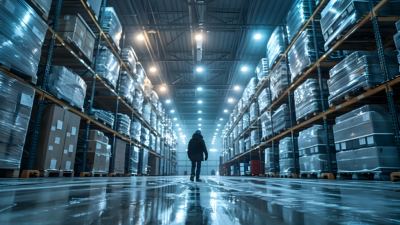In this second article of a two-part series on supply chain disruptors and their effects on retail, Gregory Healy, senior vice president and head of Colliers’ U.S. Supply Chain and Logistics Consulting team, discusses future supply chain disruptors and how they could impact retailers.
The demands on space and the commercial real estate industry (CRE) are evolving at an ever-accelerating pace to meet the needs of consumers in an ever more-connected world. Boundless digital possibilities and predictive analytics are constantly changing how, where and when consumers spend their money.
In part one of this two-part series, we explored how retailers who do not keep pace with the rapid velocity of change are falling by the wayside to make room for buoyant, innovative retailers who manage supply chain disruptions as a nudge to guide their real estate strategies. The e-commerce industry is a primary example of how sales and retail models have evolved amid supply chain disruptions, with changes in physical CRE locations acting as plot points that demonstrate the effects of these changes.
In part two of this series, we discuss some ways in which artificial intelligence (AI), automation, forecasting and predictive consumer analytics continue to shape the retail industry and, accordingly, the CRE that houses the goods that power retail. When fulfilling sales, retailers must choose between demand-driven retail and inventory-driven retail. To move forward with the appropriate strategy, retailers should employ an automated analysis of consumer data.
Smart Solutions for an Evolving Retail Industry
To provide context for some of the advancements at the center of retail supply chain disruption, AI is computer processing that seeks to replicate human interactions and reactions. There is a broad spectrum when it comes to what this can mean day-to-day, but generally, the application of AI infers the ability to sort through and analyze very large, complex data sets.
Automation is the use of equipment or software to perform tasks. Where this applies most commonly in retail is the impact of automation on warehousing and fulfillment. It’s clear where automation can affect the manual labor costs associated with the retail supply chain, but automated chatbots and similar solutions also have potential to assist in customer service-related tasks.
Predictive analytics employ the gathering of data and the use of statistical techniques to analyze historical factors and predict future behaviors or outcomes. Predicting consumer behavior is an evolved form of marketing that personalizes the retail experience for shoppers. Companies that can forecast customer buying patterns reduce supply chain costs by enabling customized, on-demand inventory. This forecasting will be especially impactful as machine learning and 3D printing gain traction.
With these advancements, the retail landscape has evolved greatly in a relatively short period of time. E-commerce is the result of consumer demand for a better, faster, more efficient retail model, with a retail market share that continues to grow. In 2018 alone, consumers spent $517.4 billion on products from U.S.-based online retailers, up 15% from $449.9 billion in 2017.
Some journalists date the first e-commerce transaction as August 11, 1994 — just 25 years ago. In those 25 years, the world has changed in ways practically impossible to predict. Developments in AI and automation aren’t quite the “robots running the register” idea that science fiction might have predicted (at least, not yet). Instead, these tools have come to fruition as forecasting and predictive analytics that assist consumers to make faster, more precise purchasing decisions and automate and streamline efficiencies in the retail supply chain.
A recent study by the IBM Institute of Business Value and the National Retail Federation (NRF) identified three intriguing points on the future of retail and automation. First, “two in five retailers and brands are already using intelligent automation, and adoption is expected to double by 2021.” Second, “intelligent automation is making the biggest impact in demand forecasting, supply chain planning and customer engagement.” And third, retail companies initially invest in automation in order to improve efficiency and save money, but after implementation, executives report that intelligent automation provides “greater operational agility, the ability to make faster, smarter decisions and improving the customer experience.”
Using AI and automation to plan, purchase and lease CRE enables supply chain efficiency, which results in an enhanced customer experience and a larger, more loyal customer base. By enacting salient CRE solutions that will survive disruptions, business leaders can create and maintain spaces to house their businesses even as the supply chain changes.
What Disruptors Are Next?
One version of the future is not warehouses full of product, waiting to be shipped and restocked, but CRE properties that house 3D printers and other machines that create product “on demand” to streamline the supply chain and create efficiencies that lead to profits.
The current e-commerce model is forward-facing, and that will not change as new technologies are integrated into the supply chain. But what will happen is the retail supply chain will continue to change from inventory-driven to demand-driven. Every time there is a pause in the supply chain — a touch — there is an associated cost. By reducing touches and changing the face of manufacturing and distribution, touches and, therefore, costs are lowered.
The term additive manufacturing, which describes 3D printing and other demand-driven manufacturing innovations, adds a layer of meaning: Businesses can create opportunities for aggregate buying and support consumer shopping habits without excess inventory. Not only is this model more socially responsible, but it’s also economical to not require more warehousing space than needed to store excess product.
Some experts predict we are 10 years from most households having a 3D printer, and by 2038 these printers will be able to print anything. In the future, retail as we know it may include files and software purchased and downloaded from the internet and used to manufacture products in our homes, a la carte. Retail will not necessarily be tied to large industrial CRE warehouses and commercial storefronts. Digital fulfillment and other manufacturing disruptors create the opportunity for retail and its industrial CRE counterparts to evolve with technology and as consumer demand requires.
The retail supply chain has proven to be flexible and adaptive through many innovations and disruptions. E-commerce has been completely integrated into the landscape in just 25 years, and the pace of innovation continues. While we can’t completely predict what the supply chain and the retail landscape will look like in another 25 years, business leaders can seek support from CRE professionals as they adapt new technology innovations and make real estate decisions that look toward future innovation.
About the Author
Gregory Healy, Senior Vice President, leads the U.S. Supply Chain and Logistics Consulting team. With over 20 years of global manufacturing and supply chain experience as both a senior executive in the corporate world, as well as owning a supply chain consulting practice and a third party logistics business, Gregory has real world experience that brings a unique perspective to the Colliers team.

 Colliers Insights Team
Colliers Insights Team
 Vytas Norusis
Vytas Norusis Craig Hurvitz
Craig Hurvitz
 Justin Smutko
Justin Smutko
 Aaron Jodka
Aaron Jodka